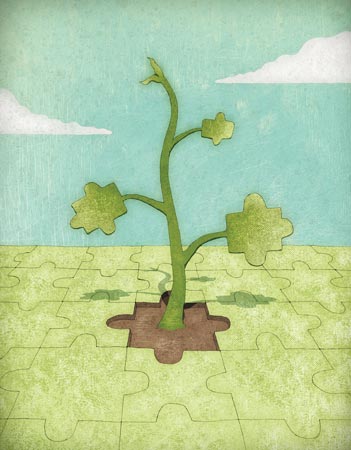 by Geoff Brown
by Geoff Brown
Illustration by Jesse Kuhn
Exceptional patient care has its roots in evidence-based practice
Cooperating Across Disciplines
Translating Knowledge for a Community
Johns Hopkins Nursing Evidence-Based Practice Model Guides Research Translation Around the Globe
Profile: Mary Terhaar, DNSc, RN
Profile: Brett Morgan, DNP ’09, CRNA
Profile: Andrea Parsons Schram, MS, RN, FNP-BC
Exceptional patient care has its roots in evidence-based practice
Adding illness to a patient’s woes is the last thing healthcare practitioners want to do. So in 2008, when Joyce Maygers, MSN, RN – who has spent 22 of her 23 years in nursing at Johns Hopkins – began to look for a research subject for her two-year Doctorate of Nursing Practice (DNP) program, she focused on urinary tract infections (UTI) in stroke patients, a group with which she has researched and worked extensively.
“There are a lot of data showing that stroke patients suffer from a high rate of urinary tract infections (UTI),” she explains, “but there wasn’t a lot of information on how to prevent them.”
That was the part that seemed strange to Maygers, because it is now common knowledge that urinary catheters (routinely given to stroke patients) are a big culprit behind UTIs. Because of her clinical experience and skill at analyzing patient outcomes, Maygers suspected there was an easy answer to this problem: maybe it wasn?t necessary to catheterize every stroke patient or leave the catheters in so long.
When she started to look at the medical reasons for automatically ordering catheters for stroke patients, she found something surprising: “It became pretty clear that we didn’t have any clinical indicators for having some of these catheters,” she says.
That finding would become the basis for Maygers’s DNP research: She would spend a year working with physicians, nurses, and other healthcare workers at Bayview to consider if catheterization was really necessary. Would she be able to change the way these patients were being treated? And if so, would it benefit them?
Show me the Evidence
Maygers’ project is an example of Evidence-Based Practice (EBP), a systematic approach for nurses to critically evaluate research evidence. It involves applying experience, observation, and scientific method in new ways to approach an ailment or treatment, and it draws heavily on the eyes and ears and wisdom of nurses, who are the healthcare practitioners with whom patients spend the most time.
EBP is gaining favor because it addresses one of the historic weaknesses of medical research, which is the length of time it takes for a discovery or innovation to enter the clinical setting, or become common practice (a process known as “translation”). Research utilization – which involves years of development and research, then years of drug and clinical trials?is a much more (albeit necessarily) arduous process.
“You may have heard that it takes 17 years from the time new evidence is generated until its acceptance [and implementation by healthcare],” says associate professor Kathleen White, PhD, RN, CEA-BC, FAAN, who co-teaches the school’s doctoral translation course, and is director of the DNP program. (This figure comes from an oft-cited study published in the Yearbook of Medical Informatics 2000*): “We’re trying to decrease that. In healthcare, in general, it should happen faster.”
“Information takes, historically, a very long time to become practice,” agrees School of Nursing Dean Martha Hill, PhD, RN, FAAN. “Let’s look at diabetic retinopathy. The findings about effective treatment were first published in ophthalmology journals. Well, diabetic practitioners don?t read ophthalmology journals. So it took 15 to 20 years for that information to diffuse out to the diabetes treatment community.”
The School of Nursing had made EBP and translation a priority for its DNP students: in fact, “Kathi White and I couldn’t find another doctoral program that has a course in translation,” says assistant professor Sharon Dudley-Brown, PhD, FNP, who teaches the course along with White.
“EBP is very inclusive,” Dudley-Brown explains. “It has expanded the definition of scientific evidence, as it encompasses not just scientific evidence, especially in nursing.”
Not only is it more flexible as a field of study, it’s more adaptable as a course of action. “EBP takes into consideration patients’ values, the skill level of practitioners, and resources available – or lack of them,” says Dudley-Brown. “It’s also more specialized than research utilization. It can be on the individual patient level. But it can also be on a larger scale, if you’re looking at how to improve unit outcomes for 40 or more patients. It’s a real win-win for everyone, especially the patients.”
By its very nature, EBP is often based in real-world observation and methodology – which means that it can more rapidly be applied to the clinical setting. It’s more of an issue of getting the information out and changing behaviors or guidelines, rather than introducing a new drug protocol or piece of equipment. Sometimes, it can be as easy as adding a couple of questions to a computer screen.
“In our DNP Program, we had a nurse at Howard County General,” White says. “She was looking at patient pain treatment and using the Assess/Implement/Reassess (AIR) system. She asked, ‘How could we improve that cycle?’ She designed a screen to go within a patient’s electronic record that included [a way to record] the AIR results. It improved documentation, and served as a trigger to make sure the cycle was being completed.”
Lessons learned for one disease can even be modified to help treatment of another. “If we learn something about working with patients with a chronic condition like diabetes,” White asks, “couldn’t we translate that for another chronic condition, like heart disease?”
EBP is the focus of the School of Nursing’s DNP Program, which was designed for professional, working nurses looking to earn a practice-focused doctorate without having to leave nursing for an extended period of time. “I’m always looking for educational opportunities,” says Maygers, who is also a trained paralegal. “It was a real challenge going back to school with a full-time job and four kids, but this was the perfect course. I was looking to get in on the ground level and get a doctoral degree, but I didn’t have seven years to devote to it. Also, I was much more interested in EBP research, not in original research. I wanted to translate existing research to best practice.”
Those new, more rapidly-introduced best practices are the real benefit of EBP, and a big strength of nursing research-produced EBP. “There’s a long history of public trust of nursing,” says professor Miyong Kim, PhD, RN, FAAN, and director of the Research Center for Cardiovascular Health in Vulnerable Populations. “We can make research relevant for people. Translation is the goal.”
Cooperating Across Disciplines
Maygers soon found she had a lot of allies in her quest to reduce the number of catheterizations – which was critical, because “without interdisciplinary support, this wouldn’t have worked.” When she showed the team the data and articles she had compiled on the number of UTI infections from catheterization, they agreed to more carefully consider ordering and maintaining the catheters for a group of stroke patients.
“The staff had to trust me,” she says, “and they couldn’t argue when I pulled out the literature to show them this was happening.” Social workers and rehabilitation services practitioners were immediately on board with Maygers, as it’s much easier to work with a patient without a catheter. Maygers asked the stroke team of healthcare providers to do two things: try not to catheterize a patient, if possible; and if a patient was catheterized, for it to be removed as soon as possible. “That’s how you go about reducing UTI,” she explains. And so, in the fall of 2009, the Bayview stroke team began to carefully reassess the use of catheters in patients.
Translating Knowledge for a Community
How does EBP translate into improving life for members of a community? Nancy Glass, PhD, MPH, RN, FAAN has worked on domestic violence from Oregon to the Congo, and she’s currently starting a new study to evaluate if certain procedures are actually working – a common EBP research project.
“We do a safety plan with a woman who is a victim of violence,” Glass explains – and this could be a businesswoman from Oregon or a farmer’s wife from the Congo. This plan involves providing the victim of domestic or partner violence with a roadmap to get herself and others away from a dangerous situation. “But no one has ever looked at if the plan works, or how it works. We are going to systemize the safety plan and tailor information to the individual needs of that woman and her children, and use that study of identify the best way to create a safety plan that works.”
Glass is a big believer in going into communities to do the best work. “We work with communities, and we work for them,” she says, “from violence prevention to cardiovascular health to cancer. Working with women who have been the victims of violence every day is not easy. In Congo, we do not have the resources of a big international aid organization. But there are small things we can do to help a community. We see which things work, and start to scale them up. It’s a team effort, and my colleagues make it easier. We have the goal of changing people’s lives in a better way as a priority.”
“We go all around the world doing good work,” says Dean Hill. “That’s part of nursing’s legacy.”
Improved Care a “Big Success”
Maygers had hoped to achieve a 10 percent reduction in the number of catheterizations: It turns out that her efforts were almost twice as successful. Patients at Bayview’s stroke center had more than 20 percent fewer catheter use days, and the resulting positive outcomes – a decrease in amount of UTIs and readmission of stroke patients for UTIs, and shorter stays by stroke patients – have been so noticeable that the process is being considered for adoption throughout all of Bayview. Maygers is quick to share credit with the nursing and medical staff and other healthcare providers who joined her initiative, but she’s obviously thrilled with her results, and for the stroke patients who dodged unnecessary infections: “It looks like it’s been a very big success.”
*Balas E.A., Boren S.A. “Managing Clinical Knowledge for Healthcare Improvement.” Yearbook of Medical Informatics 2000: Patient-centered Systems. Stuttgart, Germany: Schattauer, 2000:65Ð70.Exceptional patient care has its roots in evidence-based practice
Johns Hopkins Nursing Evidence-Based Practice Model Guides Research Translation Around the Globe
“Are we providing the best possible care?”
“The Johns Hopkins Hospital Department of Nursing was looking at that question,” says associate professor Kathleen White, PhD, RN, CEA-BC, FAAN, “and we realized we needed to develop our own model and guidelines to evaluate our patient care policies and procedures.”
From this realization was born Johns Hopkins Nursing Evidence-Based Practice Model and Guidelines, a book providing a clear and concise approach to implementing evidence-based practice. Since its publication in 2007, the book has been a Top 10 bestseller for Sigma Theta Tau International, helping thousands of nurses to translate nursing research into practice.
This spring, Johns Hopkins Nursing Evidence-Based Practice Implementation and Translation is hot off the presses, sharing vignettes, stories, strategies, and lessons learned from implementing EBP projects.
“The book shares the many avenues of translation,” says White, who served as editor in collaboration with Stephanie Poe, MScN, RN, assistant director of nursing of clinical quality and informatics at the Johns Hopkins Hospital. “Sometimes, the research doesn’t lead to change. Not all projects have enough evidence, or strong enough evidence, to make the case for a practice change. When that happens, what else can we do? There is a quality improvement study, or a pilot research study. Or sometimes, you have to search over the evidence again. And even then, sometimes the evidence isn’t always strong enough.”
Johns Hopkins Nursing Evidence-Based Practice Implementation and Translation will be available in print or as an e-book through Nursing Knowledge International (www.nursingknowledge.org). For more information, visit www.ijhn.jhmi.edu.
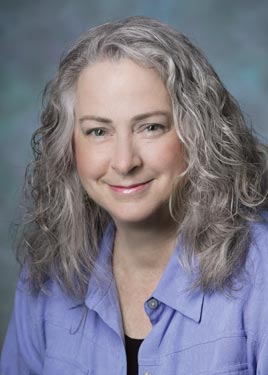 Mary Terhaar, DNSc, RN
Mary Terhaar, DNSc, RN
Assistant Professor
Department of Health Systems and Outcomes
Area of Specialty:
Noenatal & Perinatal Care
Why did you choose this specialty?”
I am captivated by the notion of helping families begin well.
Why is the translation of nursing research important?
It’s important to establish a culture in which professionals keep a questioning stance and consistently apply evidence, translate research, and apply innovation to better care for patients.
Latest project:
I have just designed a new orientation program for newly graduated nurses at Greater Baltimore Medical Center to increase consistency, critical thinking, problem solving, and progressive independence of these new staff members.
How will your project make the world a better place?
Everything we can do to prepare new nurses for a smooth transition, to help them function effectively, to find satisfaction in their work, and to bring the best evidence to practice will prepare them to lead healthcare and enjoy fulfilling careers.
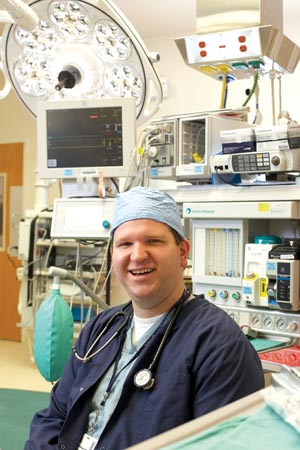 Brett Morgan, DNP ’09, CRNA
Brett Morgan, DNP ’09, CRNA
Alumnus, Doctorate of Nursing Practice Program 2009
Area of Specialty:
Anesthesiology
Why did you choose this specialty?
Patients entrust CRNAs with providing them a safe surgical experience, from maintaining normal physiologic function and providing relief from pain, to ensuring that they are protected from positioning injuries. This is a trust that I never take for granted, and is why I practice anesthesia.
Why is the translation of research important?
As clinicians we have a responsibility to our patients to provide care that is current, safe, and that has been demonstrated to be the best possible option. Translating research into practice allows nurses the opportunity to expeditiously bring to the patient or community that best practice rooted in both the science and art of nursing.
Latest project:
I evaluated a preemptive, multimodal analgesic regiment, given to specific subset of ambulatory surgical patients, for its effectiveness in decreasing pain, among other outcomes.
How will your project make the world a better place?
The inability to control pain is the greatest factor associated with postoperative morbidity. As more procedures move to the ambulatory arena, pain control will be on the forefront of issues involved in the care of surgical patients. Utilizing inexpensive, low-tech, mechanisms for decreasing pain will undoubtedly lead to better patient outcomes and satisfaction, while being responsible in the use of our valuable healthcare resources.
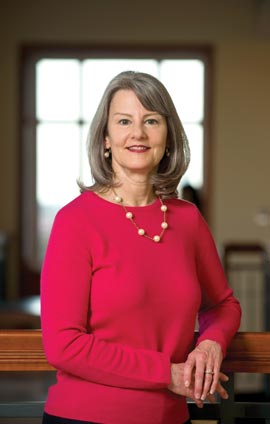 Andrea Parsons Schram, MS, RN, FNP-BC
Andrea Parsons Schram, MS, RN, FNP-BC
Student, Student, Doctorate of Nursing Practice Program
Family Nurse Practitioner with David Podgurecki, MD, PA, Mansfield, Texas
Clinical Instructor, MSN Nurse Practitioner Program, University of Texas at Arlington College of Nursing
Area of Specialty:
Clinical Instructor, MSN Nurse Practitioner Program, University of Texas at Arlington College of Nursing
Area of Specialty:
Family medicine, self-management of chronic disease such as type 2 diabetes
Why did you choose this specialty? What’s exciting about it?
I want to partner with my chronic disease patients so that they may better understand and adapt to the changes required to reduce their risk for complications or a premature death.
Why is the translation of nursing research important?
In my case, I can better evaluate the quality of the research to select treatment strategies that are shown to be effective in helping these patients better manage their chronic diseases.
Latest project:
I am utilizing a behavioral intervention called the 5As intervention to help adult type 2 diabetic patients improve their self-management in the primary care clinic where I practice.
How will your project make the world a better place?
My project will provide evidence that the 5As intervention may be an additional strategy to assist patients in improving their diabetes self-management.
 Forging Policy: How Can Doulas Improve Black Maternal Health?
Forging Policy: How Can Doulas Improve Black Maternal Health? My First Teachers in Nursing School Weren’t Nurses
My First Teachers in Nursing School Weren’t Nurses JHSON Highlights
JHSON Highlights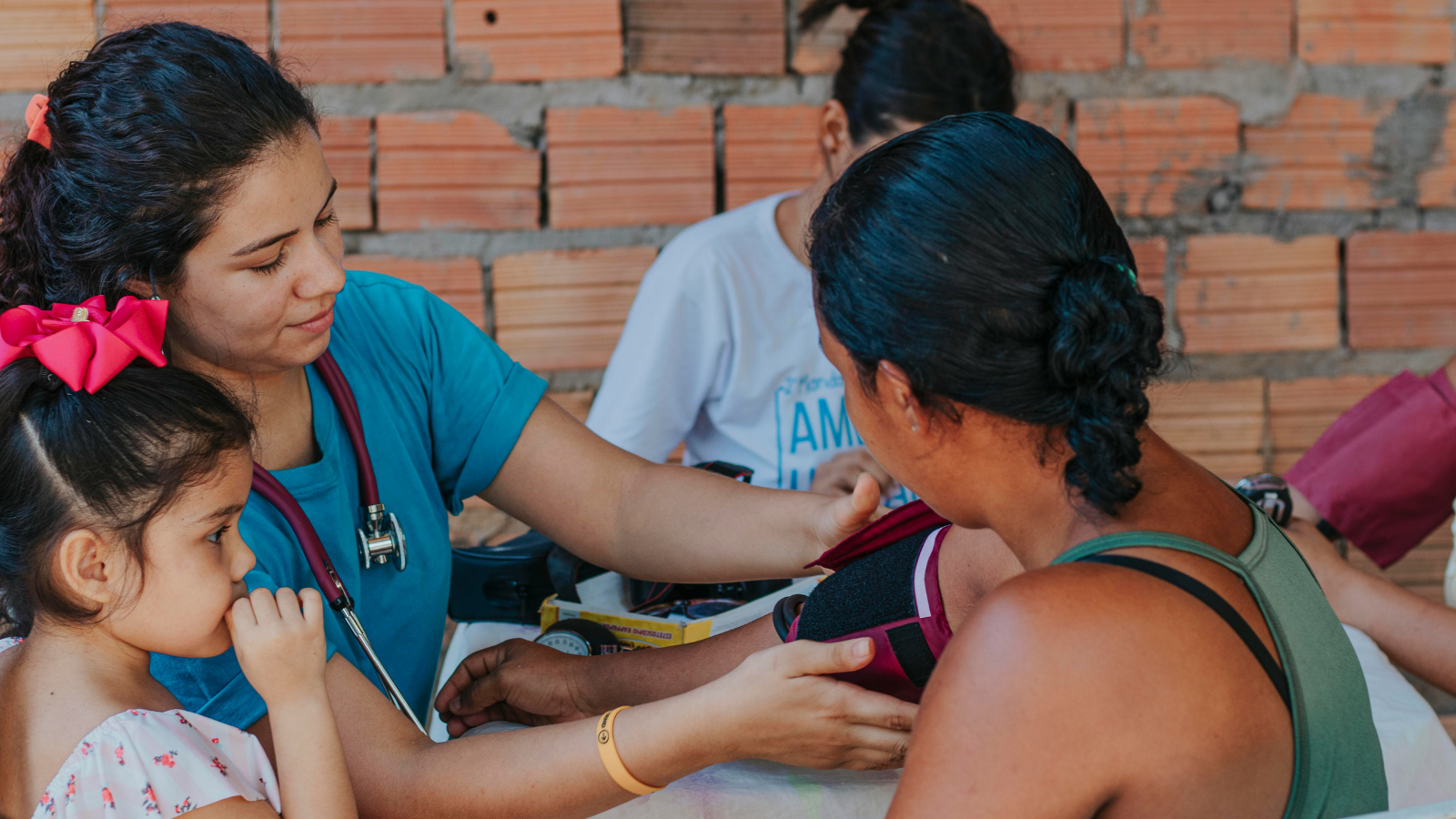 What Works: Community-Led Research Promotes Evidence-Based Strategies to Improve Indigenous Health by Championing Indigenous Nursing Practice
What Works: Community-Led Research Promotes Evidence-Based Strategies to Improve Indigenous Health by Championing Indigenous Nursing Practice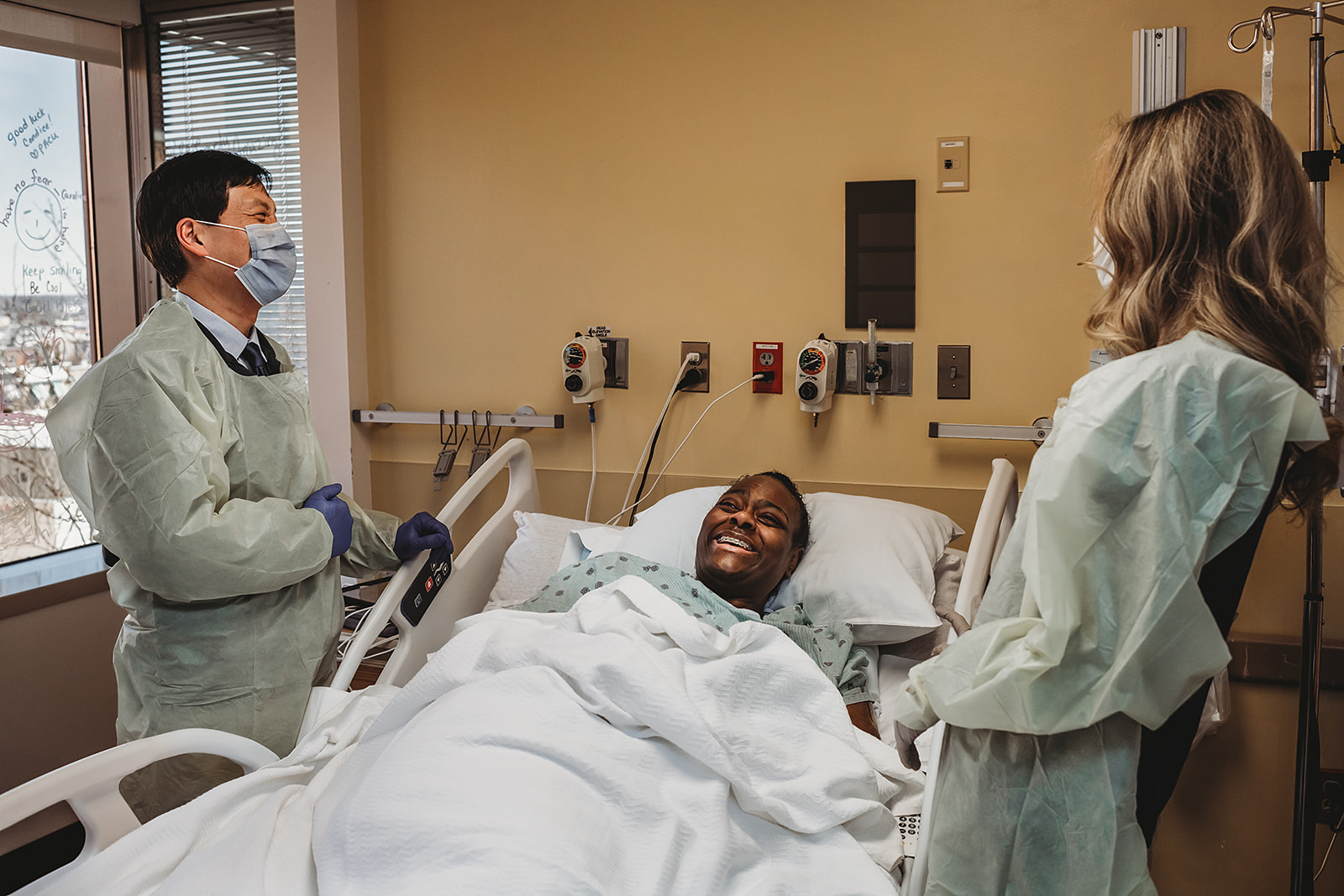 ‘Helpful, Powerful, Kind’ Palliative Care
‘Helpful, Powerful, Kind’ Palliative Care






